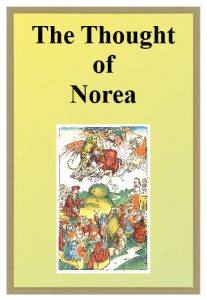Information on The Thought of Norea
BIRGER A. PEARSON WRITES, “This little writing of only fifty-two lines of Coptic text is a poetic composition in four parts. It lacks a title in the manuscript; the title employed here is a phrase occuring toward the end of the tractate (29,3). The Thought of Norea (hereafter abbreviated as Norea) is closely related to Hyp. Arch., which actually provides a setting for the text. In Hyp. Arch., Norea is represented as crying out for help (92,33-93,2), at which point the angel Eleleth intervenes. The first part of Norea is a prayer addressed to the divine hierarchy, beginning with the ‘Father of all’ and Ennoia (Barbelo in the Sethian system). The second part of the tractate begins, ‘It is Norea who cries out to them’ (27,21-22); her prayer is heard, and she is assured of being ‘joined to all of the imperishable ones’ (20,11).” (Ancient Gnosticism, p. 78)
Marvin Meyer writes, “The Thought of Norea, Three Forms of First Thought, and the Holy Book of the Great Invisible Spirit seem to assume or stress the innocence of Epinoia / Sophia such that her restoration to the Light no longer requires repentance for her unintentional but arrogant generation of the world creator without the aid of her appointed consort, as described in the Secret Book of John. Indeed, the Holy Book of the Great Invisible Spirit goes a step further than Three Forms of First Thought by attributing the origin of the archons Sakla and Nebruel to Gamaliel and Gabriel, the ministers of the two highest of the Four Luminaries, while Sophia’s function is merely limited to producing the matter over which they rule. So also in the treatise Zostrianos (9,1-11,1) Sophia serves as the model for worldly things but is not the source of the world creator who shapes it.” (The Nag Hammadi Scriptures, p. 608)
Birger A. Pearson states that the text “can provisionally be assigned to late second- or early third-century Egypt.” (Ancient Gnosticism, p. 79)
